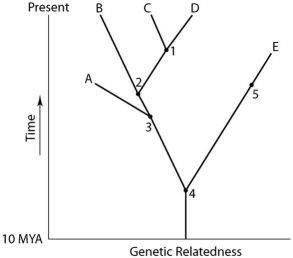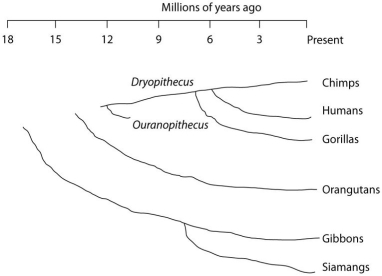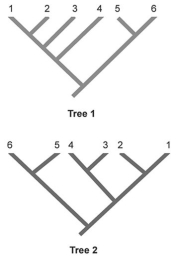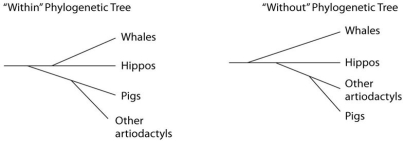A) A, B, C, D
B) C and D
C) D, E, and F
D) E, F, and G
Correct Answer

verified
Correct Answer
verified
Multiple Choice
The next questions refer to the following table,which compares the percent sequence homology of four different parts (two introns and two exons) of a gene that is found in five different eukaryotic species.Each part is numbered to indicate its distance from the promoter (e.g.,Intron I is the one closest to the promoter) .The data reported for species A were obtained by comparing DNA from one member of species A to another member of species A.
% Sequence Homology
 -Which of the following is the best explanation for the high degree of sequence homology observed in Exon I among these five species?
-Which of the following is the best explanation for the high degree of sequence homology observed in Exon I among these five species?
A) It is the most-upstream exon of this gene.
B) Due to alternative gene splicing, this exon is often treated as an intron.
C) It codes for a polypeptide domain that has a crucial function.
D) These five species must actually constitute a single species.
E) This exon is rich in G-C base pairs; thus, it is more stable.
Correct Answer

verified
Correct Answer
verified
Multiple Choice
Use this figure to answer the following questions.
 -Which extinct species should be the best candidate to serve as the outgroup for the clade whose common ancestor occurs at position 2 in the above figure?
-Which extinct species should be the best candidate to serve as the outgroup for the clade whose common ancestor occurs at position 2 in the above figure?
A) A
B) B
C) C
D) D
E) E
Correct Answer

verified
Correct Answer
verified
Multiple Choice
From the above figure,which other event occurred closest in time to the divergence of gorillas from the lineage that led to humans and chimps?
A) the divergence of chimps and humans
B) the divergence of Dryopithecus and Ouranopithecus
C) the divergence of gibbons and siamangs
D) could be either the divergence of chimps and humans OR of Dryopithecus and Ouranopithecus
E) could be either the divergence of chimps and humans OR of gibbons and siamangs
Correct Answer

verified
Correct Answer
verified
Multiple Choice
If organisms A,B,and C belong to the same class but to different orders and if organisms D,E,and F belong to the same order but to different families,which of the following pairs of organisms would be expected to show the greatest degree of structural homology?
A) A and B
B) A and C
C) B and D
D) C and F
E) D and F
Correct Answer

verified
Correct Answer
verified
Multiple Choice
Use the following figure to answer the questions below.
 Humans,chimpanzees,gorillas,and orangutans are members of a clade called the great apes,which shared a common ancestor about 18 million years ago.Gibbons and siamangs comprise a clade called the lesser apes.Tree-branch lengths indicate elapsed time.
-The great apes comprise the family Hominidae,whereas the lesser apes comprise the family Hylobatidae.If the extant organisms on the far right side of the above figure comprise the next-most exclusive (i.e.,specific) taxon,then they comprise different
Humans,chimpanzees,gorillas,and orangutans are members of a clade called the great apes,which shared a common ancestor about 18 million years ago.Gibbons and siamangs comprise a clade called the lesser apes.Tree-branch lengths indicate elapsed time.
-The great apes comprise the family Hominidae,whereas the lesser apes comprise the family Hylobatidae.If the extant organisms on the far right side of the above figure comprise the next-most exclusive (i.e.,specific) taxon,then they comprise different
A) subspecies.
B) species.
C) genuses.
D) genera.
E) orders.
Correct Answer

verified
Correct Answer
verified
Multiple Choice
 -In the phylogenetic trees above,numbers represent species and the same species are shown in both trees.Which two species are represented as sister species in Tree 2 but are not shown as sister species in Tree 1?
-In the phylogenetic trees above,numbers represent species and the same species are shown in both trees.Which two species are represented as sister species in Tree 2 but are not shown as sister species in Tree 1?
A) 1 and 2
B) 2 and 3
C) 3 and 4
D) 4 and 5
Correct Answer

verified
Correct Answer
verified
Multiple Choice
Concerning growth in genome size over evolutionary time,which of these is least associated with the others?
A) orthologous genes
B) gene duplications
C) paralogous genes
D) gene families
Correct Answer

verified
Correct Answer
verified
Multiple Choice
Assuming chimps and gorillas are humans' closest relatives,removing humans from the great ape clade and placing them in a different clade has the effect of making the phylogenetic tree of the great apes
A) polyphyletic.
B) paraphyletic.
C) monophyletic.
D) conform with Linnaeus' view of great ape phylogeny.
Correct Answer

verified
Correct Answer
verified
Multiple Choice
Cladograms (a type of phylogenetic tree) constructed from evidence from molecular systematics are based on similarities in
A) morphology.
B) the pattern of embryological development.
C) biochemical pathways.
D) habitat and lifestyle choices.
E) mutations to homologous genes.
Correct Answer

verified
Correct Answer
verified
Multiple Choice
The most important feature that permits a gene to act as a molecular clock is
A) having a large number of base pairs.
B) having a larger proportion of exonic DNA than of intronic DNA.
C) having a reliable average rate of mutation.
D) its recent origin by a gene-duplication event.
E) its being acted upon by natural selection.
Correct Answer

verified
Correct Answer
verified
Multiple Choice
Species that are not closely related and that do not share many anatomical similarities can still be placed together on the same phylogenetic tree by comparing their
A) plasmids.
B) mitochondrial genomes.
C) homologous genes that are poorly conserved.
D) homologous genes that are highly conserved.
Correct Answer

verified
Correct Answer
verified
Multiple Choice
Use the following information to answer the questions below. Traditionally,zoologists have placed birds in their own class,Aves.More recently,molecular evidence has shown that birds are more closely related to reptiles than their anatomy reveals.Genetically,birds are more closely related to crocodiles than crocodiles are to turtles.Bird anatomy has become highly modified as birds have adapted to flight,without their genes having undergone nearly as much change. -Traditional zoologists have long agreed that birds evolved from dinosaurs.What keeps such zoologists from agreeing that birds,like dinosaurs,should be considered reptiles?
A) There is not yet enough evidence to be sure.
B) Stubbornness, insofar as they are unwilling to change their thinking when new data warrants it.
C) They deny the validity of genetic molecular data.
D) They differ in what they consider to be important traits for assigning organisms to the class Reptilia.
Correct Answer

verified
Correct Answer
verified
Multiple Choice
Use the following figure to answer the questions below.
 Humans,chimpanzees,gorillas,and orangutans are members of a clade called the great apes,which shared a common ancestor about 18 million years ago.Gibbons and siamangs comprise a clade called the lesser apes.Tree-branch lengths indicate elapsed time.
-Together,the lesser apes and great apes shared a common ancestor most recently with other members of their
Humans,chimpanzees,gorillas,and orangutans are members of a clade called the great apes,which shared a common ancestor about 18 million years ago.Gibbons and siamangs comprise a clade called the lesser apes.Tree-branch lengths indicate elapsed time.
-Together,the lesser apes and great apes shared a common ancestor most recently with other members of their
A) order.
B) class.
C) subclass.
D) subfamily.
E) family.
Correct Answer

verified
Correct Answer
verified
Multiple Choice
Why is the Kingdom Monera no longer part of the modern classification system?
A) It is too confusing.
B) It had members in two different domains.
C) It had included both prokaryotes and eukaryotes.
D) It had included both unicellular and multicellular organisms.
E) B and C
Correct Answer

verified
Correct Answer
verified
Multiple Choice
Use the following information and figure to answer the questions below.
Traditionally,whales and hippopotamuses have been classified in different orders,the Cetacea and the Artiodactyla,respectively.Recent molecular evidence,however,indicates that the whales' closest living relatives are the hippos.This has caused some zoologists to lump the two orders together into a single clade,the Cetartiodactyla.There is no consensus on whether the Cetartiodactyla should be accorded order status or superorder status.This is because it remains unclear whether the whale lineage diverged from the lineage leading to the hippos before or after the other members of the order Artiodactyla (pigs,camels,etc.) diverged (see the figure below) .
 This figure contrasts the "Within the artiodactyls" origin of the whale lineage with the "Without the artiodactyls" origin of the whale lineage.
-What can be properly inferred from the above figure?
This figure contrasts the "Within the artiodactyls" origin of the whale lineage with the "Without the artiodactyls" origin of the whale lineage.
-What can be properly inferred from the above figure?
A) In the "Without" tree, pigs are more distantly related to hippos than is depicted in the "Within" tree.
B) In the "Without" tree, pigs are more closely related to hippos than are whales.
C) In the "Within" tree, pigs are more closely related to whales than they are to hippos.
D) The "Without" tree is more consistent with molecular evidence than is the "Within" tree.
E) In the "Within" tree, all artiodactyls, including hippos, are more closely related to each other than any are to the whales.
Correct Answer

verified
Correct Answer
verified
Multiple Choice
Neutral theory proposes that
A) molecular clocks are more reliable when the surrounding pH is close to 7.0.
B) most mutations of highly conserved DNA sequences should have no functional effect.
C) DNA is less susceptible to mutation when it codes for amino acid sequences whose side groups (or R groups) have a neutral pH.
D) DNA is less susceptible to mutation when it codes for amino acid sequences whose side groups (or R groups) have a neutral electrical charge.
E) a significant proportion of mutations are not acted upon by natural selection.
Correct Answer

verified
Correct Answer
verified
Multiple Choice
Which statement represents the best explanation for the observation that the nuclear DNA of wolves and domestic dogs has a very high degree of sequence homology?
A) Dogs and wolves have very similar morphologies.
B) Dogs and wolves belong to the same order.
C) Dogs and wolves are both members of the order Carnivora.
D) Dogs and wolves shared a common ancestor very recently.
Correct Answer

verified
Correct Answer
verified
Multiple Choice
The domestic dog,red fox,and wolf belong to the family Canidae.The dog is Canis lupus familiaris,the red fox is Vulpes vulpes,and the wolf is Canis lupus.Which of the following statements is correct?
A) All three canids are in different genera.
B) The red fox is in the same family, but of a different genus, than wolves and dogs.
C) All three canids should successfully breed with one another.
D) All three belong to the same genera but are different species.
E) All three canids live on different continents.
Correct Answer

verified
Correct Answer
verified
Multiple Choice
The reason that paralogous genes can diverge from each other within the same gene pool,whereas orthologous genes diverge only after gene pools are isolated from each other,is that
A) having multiple copies of genes is essential for the occurrence of sympatric speciation in the wild.
B) paralogous genes can occur only in diploid species; thus, they are absent from most prokaryotes.
C) polyploidy is a necessary precondition for the occurrence of sympatric speciation in the wild.
D) having an extra copy of a gene permits modifications to the copy without loss of the original gene product.
Correct Answer

verified
Correct Answer
verified
Showing 21 - 40 of 91
Related Exams